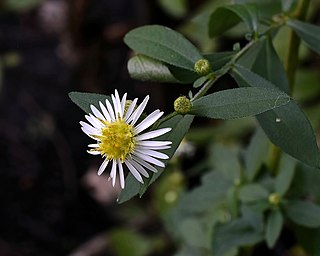
Symphyotrichum novae-angliae is a species of flowering plant in the aster family (Asteraceae) native to central and eastern North America. Commonly known as New England aster, hairy Michaelmas-daisy, or Michaelmas daisy, it is a perennial, herbaceous plant usually between 30 and 120 centimeters tall and 60 to 90 cm wide.

Astereae is a tribe of plants in the family Asteraceae that includes annuals, biennials, perennials, subshrubs, shrubs, and trees. They are found primarily in temperate regions of the world. Plants within the tribe are present nearly worldwide divided into over 250 genera and more than 3,100 species, making it the second-largest tribe in the family behind Senecioneae.

Heterotheca, are North American plants in the family Asteraceae.

Liatris pycnostachya, the prairie blazing star, cattail gayfeather or cattail blazing star, is a perennial plant in the Asteraceae family that is native to the tallgrass prairies of the central United States.
Erigeron serpentinus is a rare species of flowering plant in the family Asteraceae known by the common names serpentine fleabane and serpentine daisy. It is endemic to Sonoma County, California, where it is known from three occurrences in and around The Cedars, in the Coast Ranges east of Salt Point and west of Healdsburg. There are an estimated 1100 individuals in existence. The Cedars is a canyon habitat with serpentine soils surrounded by non-serpentine terrain; it is home to several rare serpentine-endemic plant species. This daisy was discovered there and described to science in 1992.
Heterotheca monarchensis is a rare species of flowering plant in the family Asteraceae known by the common names monarch goldenaster and sequoia false goldenaster. It is endemic to Fresno County, California, where it is known from only one location near Boyden Cave in the Kings River Canyon. It grows in the limestone cliffs of this Sierra Nevada river canyon, along with a few other rare local endemics. The plant was discovered in July, 1995, and described to science as a new species in 1996.
Eurybia horrida is a species of flowering plant in the family Asteraceae known by the common names spiny aster and horrid herrickia. It is native to Colorado and New Mexico in the United States, where it occurs only in the Canadian River basin. It most often included in genus Eurybia.

Liatris punctata is a species of flowering plant in the family Asteraceae known by the common names dotted gayfeather, dotted blazingstar, and narrow-leaved blazingstar. It is native to North America, where it occurs throughout the plains of central Canada, the central United States, and northern Mexico.

Symphyotrichum dumosum is a species of flowering plant of the family Asteraceae commonly known as rice button aster and bushy aster. It is native to much of eastern and central North America, as well as Haiti and Dominican Republic. It is a perennial, herbaceous plant that may reach a height of 1 meter.
Erigeron klamathensis is a North American species of flowering plant in the family Asteraceae known by the common name Klamath fleabane or Klamath daisy. It had been collected by botanists for many years and generally regarded as part of E. foliosus. It was not recognized as a distinct species until 2004.

Eurybia kingii is a North American species of flowering plants in the family Asteraceae, called the King's serpentweed or King's aster. It has been found only in the State of Utah in the western United States.

Heterotheca camporum, known by the common name lemonyellow false goldenaster, is a North American species of flowering plant in the family Asteraceae. It is found only in the central United States, primarily the Ozarks, the Cumberland Plateau, and the middle Mississippi Valley. There are reports of additional populations in the Northeast, the Southeast, and in the Great Lakes region, but these appear to be waifs or naturalizations.
Heterotheca pumila, the alpine goldenaster, is a North American species of flowering plant in the family Asteraceae. It grows in alpine and subalpine regions in the mountains of the western United States. It has been found the Rocky Mountains in Wyoming, Colorado, Utah, and New Mexico.
Heterotheca stenophylla, called the stiffleaf goldenaster, is a North American species of flowering plant in the family Asteraceae. It grows on the Great Plains of the central United States from South Dakota south to Texas and New Mexico.

Heterotheca villosa, commonly known as the hairy goldenaster, is a species of flowering plant in the family Asteraceae found in central and western North America.

Symphyotrichum ontarionis is a species of flowering plant in the family Asteraceae native to eastern North America. Commonly known as Ontario aster and bottomland aster, it is a perennial, herbaceous plant that may reach heights of 120 centimeters. Each flower head has many tiny florets put together into what appear as one.

Symphyotrichum racemosum is a species of flowering plant native to parts of the United States and introduced in Canada. It is known as smooth white oldfield aster and small white aster. It is a perennial, herbaceous plant in the family Asteraceae. It is a late-summer and fall blooming flower.

Sanrobertia is a genus of flowering plants within the subtribe Symphyotrichinae of the family Asteraceae. It is monotypic, meaning there is only one species within the genus. Sanrobertia gypsophila is a rare endemic known only from Nuevo León, Mexico.

Symphyotrichum molle is a species of flowering plant in the aster family (Asteraceae) endemic to the Bighorn Mountains of Montana and Wyoming in the United States. Commonly known as soft aster, it is a perennial, herbaceous plant that ranges from 30 to 60 centimeters in height.
Lupinus prunophilus, commonly known as the hairy bigleaf lupine or chokecherry lupin, is a medium-sized herbaceous plant that grows in the Great Basin and other parts of the U.S. interior between the Sierra-Nevada and the Rockies. It is a close relative and very similar to Lupinus polyphyllus and is considered a subspecies by some botanists.














